ASUS P8Z68-V PRO Review: Our First Z68 Motherboard
by Ian Cutress on May 11, 2011 3:13 AM EST- Posted in
- Motherboards
- Asus
- Z68
LAN Speed Test
LAN Speed Test is a freeware program designed for testing the network connection between two PCs on a home network. The speed of the transfer is limited by the lowest common denominator on the network, so if you have gigabit Ethernet capable computers but a 100 Mbit capable router, you are limited to 100 Mbit transfer. Note that this is really a formality – if a network port is rated at 1 Gbps, then chances are that it will hit at least 90+% of this value. The main test here is CPU usage, and how much is offloaded by the controller. For this test, we use LAN Speed Test to transfer a 1000 MB file across a home network with a 100 Mbps lowest common speed to the same machine each time, in a read/write scenario. CPU usage is taken as a visual max/average from task manager.
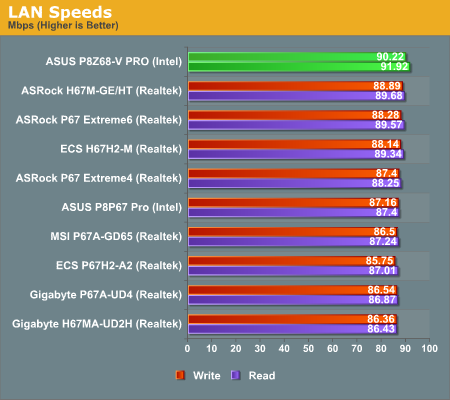
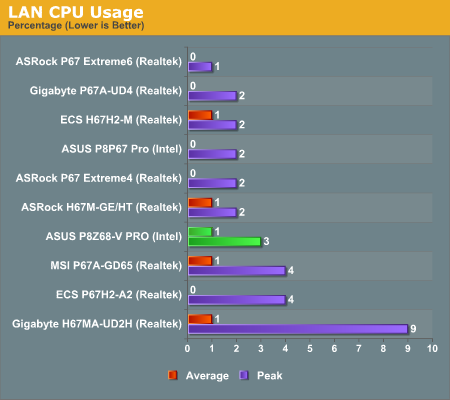
The board comes top in our read/write speed test by a decent margin, considering the 100 Mbps limit imposed by our router.
USB Speed
For this benchmark, we run CrystalDiskMark to determine the ideal sequential read and write speeds for the USB port using our 64GB Patriot SuperSpeed USB 3.0 drive. Then we transfer a set size of files from the SSD to the USB drive, and monitor the time taken to transfer. The files transferred are a 1.52 GB set of 2867 files across 320 folders – 95% of these files are small typical website files, and the rest (90% of the size) are the videos used in the Sorenson Squeeze test.

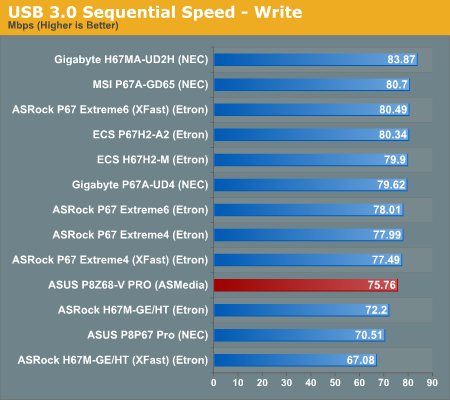
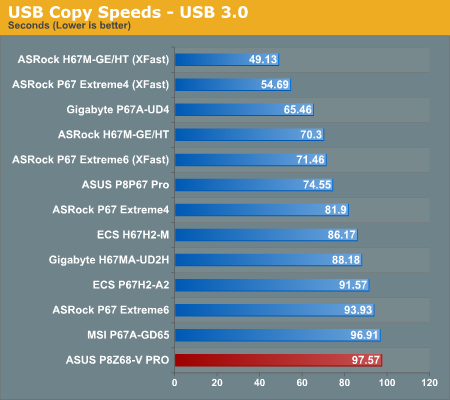
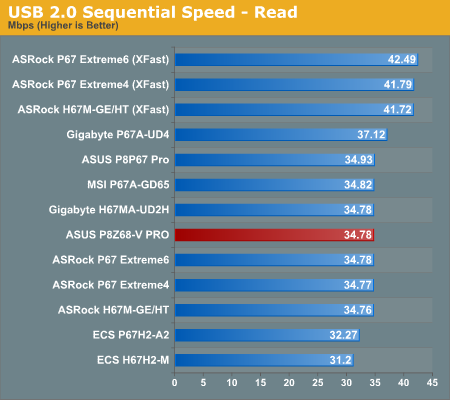


The board isn't setting any USB records, being near the bottom compared to other boards we've tested.
SATA Testing
We also use CrystalDiskMark for SATA port testing. The operating system is installed on the Micron RealSSD C300, which is rated at 355 MB/s read and 215 MB/s write, and the sequential test is run at the 5 x 1000 MB level. This test probes the efficiency of the data delivery system between the chipset and the drive, or in the case of additional SATA ports provided by a third party controller, the efficiency between the controller, the chipset and the drive.
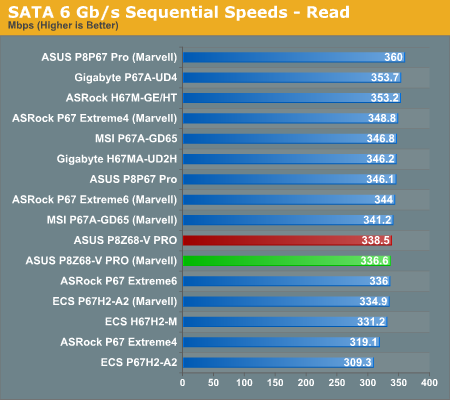
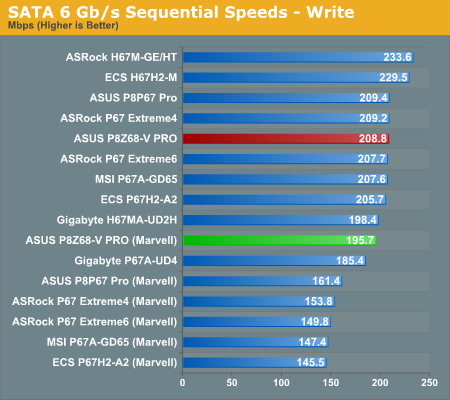

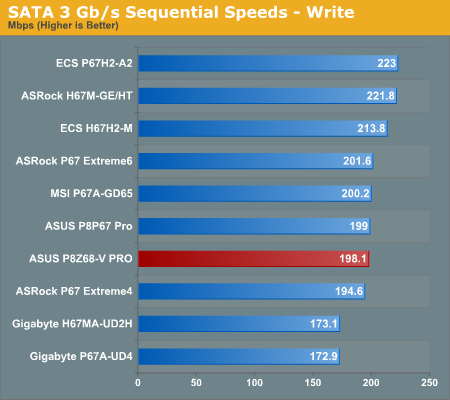
The ASUS board is near the middle of the pack when it comes to SATA speeds.
DPC Latency
Deferred Procedure Call latency is a way in which Windows handles interrupt servicing. In order to wait for a processor to acknowledge the request, the system will queue all interrupt requests by priority. Critical interrupts will be handled as soon as possible, whereas lesser priority requests, such as audio, will be further down the line. So if the audio device requires data, it will have to wait until the request is processed before the buffer is filled. If the device drivers of higher priority components in a system are poorly implemented, this can cause delays in request scheduling and process time, resulting in an empty audio buffer – this leads to characteristic audible pauses, pops and clicks. Having a bigger buffer and correctly implemented system drivers obviously helps in this regard. The DPC latency checker measures how much time is processing DPCs from driver invocation – the lower the value will result in better audio transfer at smaller buffer sizes. Results are measured in microseconds and taken as the peak latency while cycling through a series of short HD videos—under 500 microseconds usually gets the green light, but the lower the better.
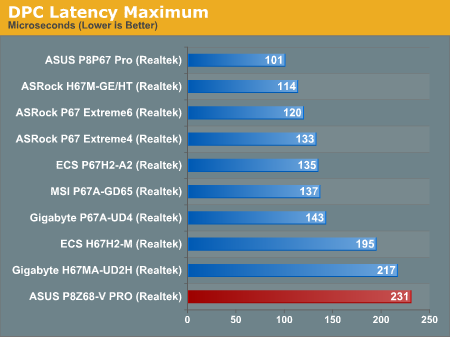
The ASUS board may have come bottom in the DPC test, but the result is stil under 500 microseconds, and for the most part it was under 120.










95 Comments
View All Comments
tomoyo - Wednesday, May 11, 2011 - link
Haha I love russia lines.But I do think a number of us want a system that is the fastest, lowest power, and quietest. Conflicting options, but options I always go for in every system. Also cheapest is nice also. It seems like a much better challenge than the lame boring crap of fastest o/c. Only the truly awesome can mix everything together :)
xinaes - Thursday, May 12, 2011 - link
Conflicting, like anything else in life. We want to know what options are available and to find the best balance / compromise for our needs.L. - Thursday, May 12, 2011 - link
Again, you want the greenest solution ?Undervolting is NOT it.
Sandy Bridge != reasonably powerful.
tomoyo - Wednesday, May 11, 2011 - link
Uh what? Hello sandy bridge is amazingly low power consumption AND fast. Nobody wants a piece of @#$% atom or e series when you can get something fast AND low power consumption.L. - Thursday, May 12, 2011 - link
Errr .. you might want to go back to school and learn how to compare numbers ...There is NO comparison between an e-350 and a Sandy Bridge in terms of power consumption - besides said chip is not really a piece of crap if you don't play modern games.
NeBlackCat - Friday, May 13, 2011 - link
Which do you think wins in power efficiency, for the widest range of tasks from nothing to re-encoding a BlueRay?Stuka87 - Wednesday, May 11, 2011 - link
It would be cool to see a review done that way to see what kind of power savings there are. My guess they will be very little since just about every modern chips declocks itself constantly.But this motherboard is NOT for that segment. This is a top end performance board. NOT the board to use if you want yo conserve energy.
vol7ron - Wednesday, May 11, 2011 - link
The procs go into a low-power/normal state when not in use and they jump in clocks when workloads demand, but that low-power state is probably spec defined, and not the min that you could get. Just like, if you were to OC the chip yourself, you'd get more jump than the max boost.For these reasons, if a person wanted to manually set an undervol7ed/underclocked configuration, it'd be nice to know before a purchase. I don't think it's a fair assumption to say that same user would always use that configuration. They might do video/photo editing or gaming very sparingly and just want to conserve power when and where they can.
cyklonman - Wednesday, May 11, 2011 - link
Sandy bridge undervolt it self to rougly 4W in idle, undervolting at load will gain more but there is no real reason.NeBlackCat - Wednesday, May 11, 2011 - link
But when you're not at idle...